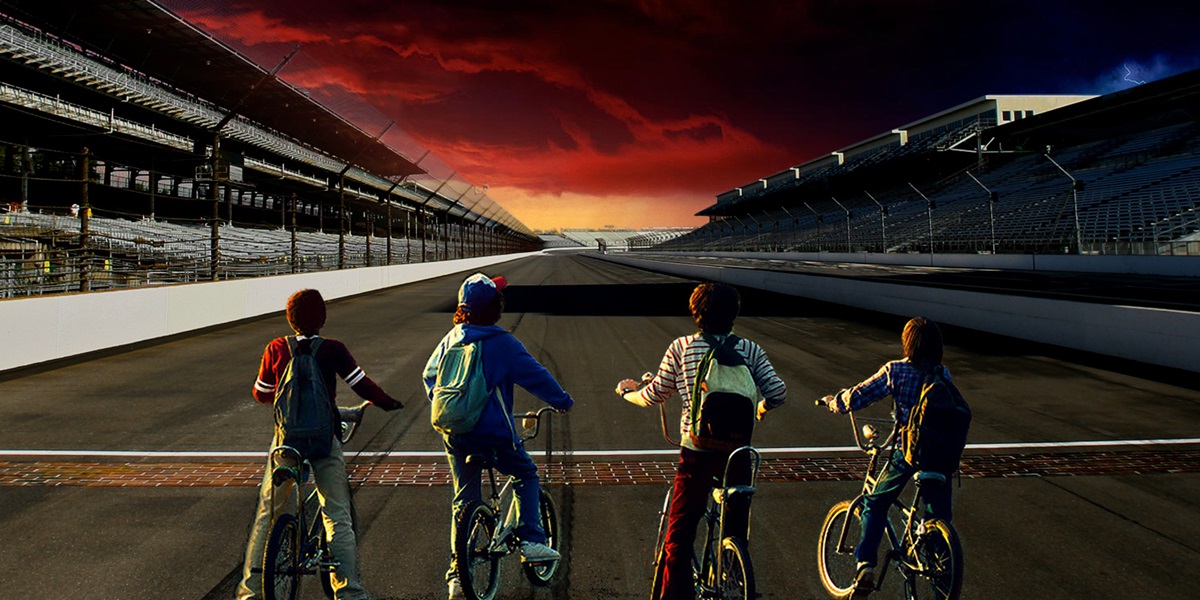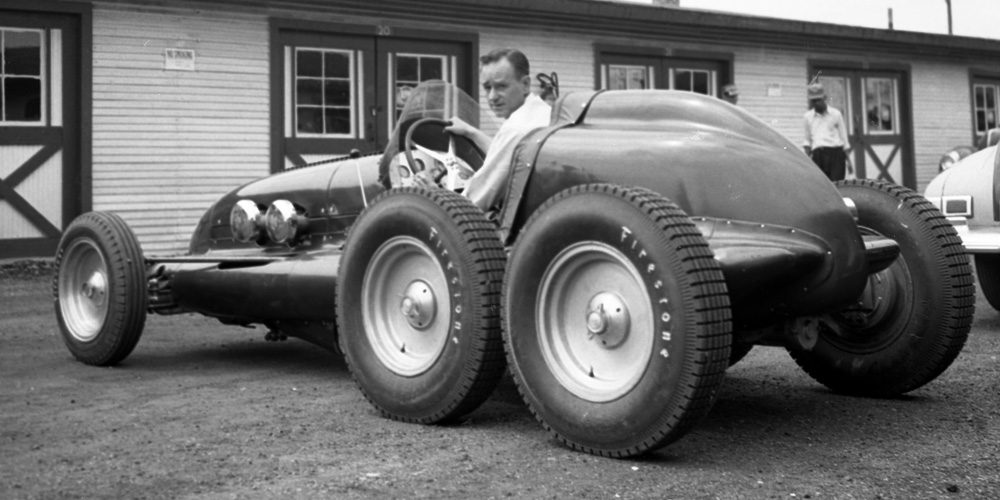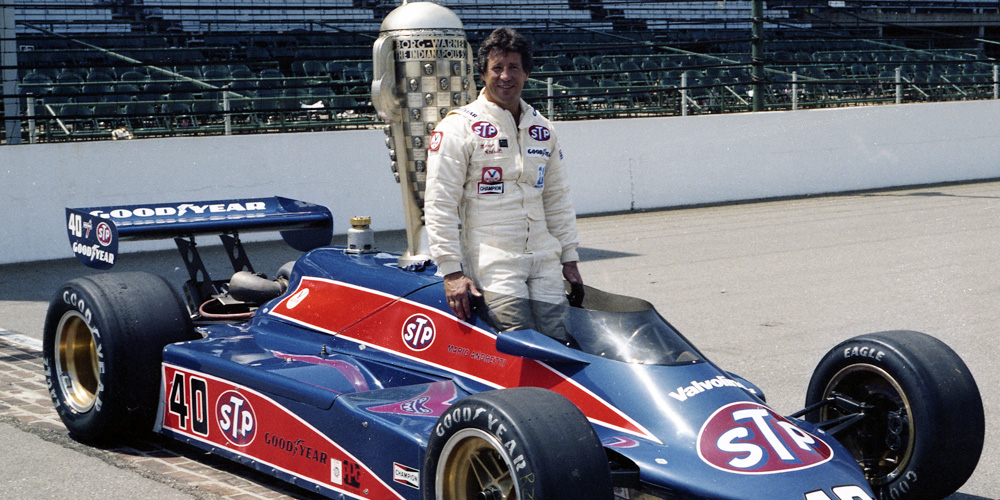
It's Not Just Hawkins, Indiana: 'Stranger Things' Have Occurred through Years at IMS
October 27, 2017 | By Paul Kelly, Indianapolis Motor Speedway
Millions of avid viewers around the world dove Oct. 27 into the second season of the wildly popular Netflix series “Stranger Things.” The science-fiction drama chronicles strange things afoot in the fictional town of Hawkins, Indiana, where a young boy’s sudden disappearance unearthed a young girl with otherworldly powers.
The success of the show, which has mushroomed from a cult classic into a mainstream hit after just one season, caused us at the Indianapolis Motor Speedway to think about some of the “Stranger Things” that have happened in the last 108 years at the “Racing Capital of the World.” Here a few that come to mind:
1912: Ralph DePalma led 196 of the first 198 laps of the second Indianapolis 500 and was ahead by 5 ½ laps when his privately entered Mercedes Grand Prix car broke down just 1 ¼ laps short of victory. Instead of jumping out of his crippled car and heading to the pits, DePalma and his riding mechanic ran to the back of the heavy car and tried to push it to the finish. The effort was greatly appreciated by the crowd but abandoned after several hundred yards, with Joe Dawson passing DePalma’s car for victory.

1948: Billy Devore qualified 20th for the 1948 Indianapolis 500 with a creditable speed of 123.967 mph, but his car probably was the most-discussed on the property that month, even more than those of race winner Mauri Rose and pole sitter Rex Mays. Why? Devore’s car had SIX wheels! The front featured the conventional two wheels, but there were four wheels on dual axles in the rear. Former dirt track driver Pat Clancy, who also owned a small trucking company, thought the double rear axle concept for trucks might work at the Speedway. Devore finished 12th, and Jackie Holmes drove the strange car in 1949, dropping out with a broken driveshaft after 65 laps. The car was converted into a standard four-wheeler for the 1950 race.
1969: Leon “Jigger” Sirois never qualified for the Indianapolis 500 in seven consecutive tries from 1969-75, but he’ll live forever in IMS lore due to one of the strangest qualifying days in Indianapolis 500 history in 1969. On Pole Day, Sirois drew the first in line to attempt to qualify. After a long rain delay, he entered the 2.5-mile oval and turned respectable speeds for his first three laps. But his team owner waved off the run at the start of Sirois’ final lap, believing it wasn’t fast enough to survive against the long line of drivers waiting to qualify that day. But rain resumed when Arnie Knepper entered the track on the next qualifying attempt and continued for the next two days, washing out the entire first weekend of qualifying. If Sirois’ owner let him complete his fourth qualifying lap, he would have been on the pole for the race based on the rules of that time. Sirois waved off three attempts on the second qualifying weekend, thinking his runs were too slow. The qualifying rules were changed for the next year, guaranteeing all cars in line on the first day of qualifying a chance to qualifying for the pole position.

1981: In one of the most famous pictures in racing, Mario Andretti is posing as the race winner next to the Borg-Warner Trophy the morning after the 1981 Indianapolis 500. But the history books show Bobby Unser as the race winner. What happened? Unser crossed the finish line first for his third victory in “The Greatest Spectacle in Racing,” but race officials ruled immediately after the race that Uncle Bobby passed cars illegally under caution after a pit stop on Lap 149, awarding the victory to Andretti and dropping Unser to second. But a long appeals process ended up with Unser being declared the winner Oct. 9 of that year in perhaps the strangest, most controversial finish in Indy 500 history.
1985: Danny Sullivan dove low in Turn 1 on Lap 120 to seize the lead of the Indianapolis 500 from Mario Andretti. Then the rear of Sullivan’s Team Penske entry slid upon exiting Turn 1, and he appeared to be headed into the outside wall and an early exit. Sullivan’s car spun 1 ¼ times in the “south chute,” but he skillfully kept it from touching the wall or any other car. Sullivan cruised to the pits, where engineers miraculously found no flat spots on his tires despite the spin. Sullivan quickly returned to the race, passed Andretti for the lead 20 laps later and went on to his famous “Spin and Win” victory in one of the strangest, most exciting incidents in IMS history.
1987: Al Unser earned his record-tying fourth Indianapolis 500 victory in 1987. There was nothing strange about that achievement – Unser is one of the greatest drivers to ever turn a wheel at the Speedway. But he became the oldest driver ever to win “The Greatest Spectacle in Racing” at 47 years, 360 days, achieving the feat in a Team Penske show car! Unser was replaced at Team Penske by Danny Ongais but got the call back to the team after Ongais suffered a concussion during an accident in practice. Penske teammates Rick Mears and Danny Sullivan determined during practice that the team’s 1986 chassis performed better than its new car, so a scramble was on to find a year-old chassis for Big Al. The team found one on display in a hotel near its then-headquarters in Reading, Pennsylvania, and Unser ended up winning the race in that car.

1992: Race Day for the 1992 Indianapolis 500 dawned with unseasonably cold temperatures and high winds, with the high reading on the thermometer for the entire day reaching just 58 degrees. As hundreds of thousands of fans looked on while wearing heavy jackets and even winter hats, pole sitter Roberto Guerrero’s car veered left exiting Turn 2 on the second pace lap and clipped the inside wall, damaging his car and ending his day before he could even take the green flag. Guerrero’s car, on cold tires, lost traction under acceleration in one of the strangest starts to an Indianapolis 500.
1994: The excitement for the inaugural Brickyard 400 swept across the racing world in late 1993 and throughout 1994. The stock car race at IMS and the first race of any kind at the facility other than the Indianapolis 500 since 1916 created a sellout crowd months in advance and an instant jewel in NASCAR’s crown. All of the superstars of the sport during that era – Dale Earnhardt, Rusty Wallace, Jeff Gordon, Bill Elliott, Mark Martin, Ken Schrader, Ricky Rudd, Darrell Waltrip and more – wanted to win the pole and the race at such a historical event. But no one saw what was coming in qualifying, when an incredible 85 cars competed for the 43 starting spots. Veteran Rick Mast, who earned no wins and just four poles in 364 starts during his Cup career, drove his Jackson Brothers Motorsports Oldsmobile to the pole at 172.414 mph. Mast finished 22nd the next day in the race, but his place in Brickyard 400 lore already was secure.
2005: In perhaps the strangest race in the century-plus history of IMS, Michael Schumacher won the United States Grand Prix Formula One event, a race that featured just six cars. All 14 cars that used Michelin tires lined up for the formation lap and then pulled into the pits before taking their spots on the grid on the grounds of safety, as Michelin tires suffered repeated failures during the weekend. The six drivers using Bridgestone tires – which had no problems all weekend – raced for all 73 laps, with Schumacher beating Ferrari teammate Rubens Barrichello by 1.522 seconds. Tiago Monteiro finished third in a Jordan, the only podium finish of his otherwise forgettable two-year F1 career. Strange, indeed.

2008: The gravity-defying stars of the MotoGP World Championship raced at IMS for the first time in 2008. Race Day was marred by the remnants of Hurricane Ike moving through Central Indiana, with a wet track and steady winds of 30 mph, with 60-mph gusts. In a testament to the bravery -- and some say insanity! – of the riders, the show went on despite the swirling winds. Valentino Rossi and American Nicky Hayden engaged in a spirited duel on a wet track featuring large puddles before Rossi won in a race that officials shortened due to the weather. On one lap, Hayden’s bike moved sideways at the end of the backstretch on the IMS road course, appearing to hydroplane in a patch of water. Hayden, who saved the machine from crashing through incredible skill, revealed afterward the water didn’t cause the bike to jump sideways – a heavy wind gust was the culprit! It was perhaps the strangest weather conditions in which a race ever took place at IMS.
2011: JR Hildebrand appeared to be headed to glory on the final lap of the Indianapolis 500, leading Scott Dixon by 3.8 seconds. Hildebrand cruised through Turns 1, 2 and 3 and was one corner away from becoming the first American winner of the “500” since Sam Hornish Jr. in 2006. But the unimaginable happened: Hildebrand drifted high in Turn 4 to avoid the slower, lapped car of Charlie Kimball and hit the SAFER Barrier. Hildebrand kept his foot to the floor, his crippled car scraping along the frontstretch wall in a meteor shower of sparks, trying to win. But Dan Wheldon emerged from the smoke, debris and chaos on the front straightaway, shooting the gap between Kimball low and Hildebrand high to cross the finish line 2.1 seconds ahead to earn an unlikely second Indianapolis 500 victory. It was the only lap Wheldon led all day, and he was ahead only the last few hundred yards.